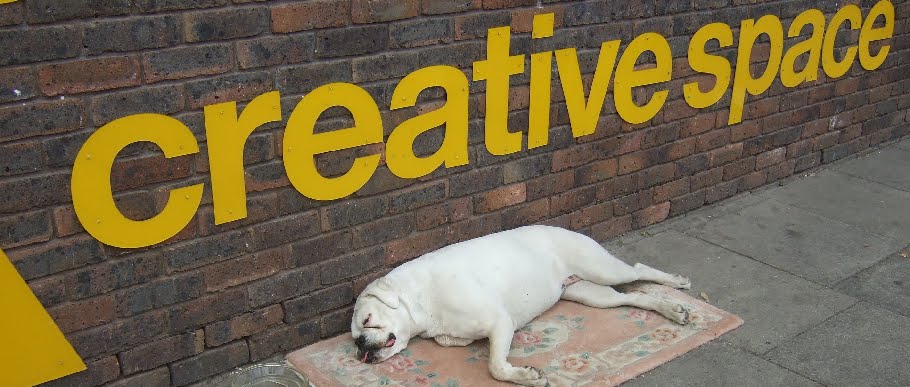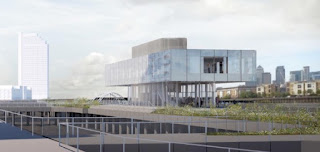Sunday, 11 October 2020
Barclays' branch closure set to make Deptford a banking desert
Wednesday, 2 September 2020
Got a planning objection? If you live in Lewisham you can SoD off!
Saturday, 15 August 2020
Developer appeals over McMillan Street plans
Campaigners are asking local residents and community groups in Deptford to write to the Planning Inspectorate to reiterate their objections against an application to build on land on the south edge of Charlotte Turner Gardens.
The application for a new three-storey block of flats on McMillan Street was refused by Greenwich Council earlier this year on the grounds of being an 'unsympathetic and over-dominant addition to the existing street scene and park'; for 'failing to provide an acceptable internal and external living environment for prospective residents' and for having 'an adverse impact on the amenity of adjoining occupiers as a result of a loss of outlook, increased sense of enclosure and a loss of light/overshadowing'.
But the developer has now taken the case to appeal, which means that a final decision will be made by the Planning Inspectorate whose inspector will decide whether to uphold the council's decision, or overturn it.
Monday, 8 June 2020
Convoys Wharf development plans - a cultural desert?
Now they are back - and this Tuesday will be the subject of the first strategic planning committee to be held using the online meetings platform.
One big question will be how the council plans to address ongoing concerns over the lack of any cultural strategy for the site and the failure of the applicant's efforts to establish a cultural steering group for what is arguably one of the most historically-significant pieces of land in the borough.
With the new online platform, the public are able to 'attend' meetings by watching them online; while it takes away the fun of the unscripted public heckling that often forms part of the rich tapestry of council planning meetings, it does mean that if you live in Deptford, there's no longer any need to travel all the way to Catford to experience that sinking feeling when another council officer refers to Griffin Square or a committee member reveals their ignorance of Deptford's rich heritage and cultural background.
I've held off from much analysis of the detailed planning applications for several reasons - mostly that the larger-scale aspects of these schemes have already been approved, and the only aspects up for debate ('reserved matters') are the layout and scale, within the parameters of the outline planning permission; the appearance; the landscaping, and the access. Also because life has a habit of getting in the way at times.
But I couldn't let the moment pass without some comments on what is being put before our elected members this week - and to highlight the lacklustre efforts to reflect the heritage of the site, a failure that will come as no surprise to those of us who have followed the progress of the development.
For those new to Deptford, Convoys Wharf is name latterly given to the huge empty swathe of land down on the river front; formerly the site of Henry VIII's royal dockyard, established in 1513, and which became England's premier dockyard and a focus of wooden ship building in the 17th century. It has many other important historic links - Samuel Pepys was a regular visitor in his role as Admiralty of the Navy, and fellow diarist and contemporary John Evelyn lived in Sayes Court manor house on the site where he established his garden. Russian tsar Peter the Great rented Evelyn's house for three months, when he came to Deptford dockyard to study shipbuilding, and notoriously trashed his holly hedge in a drunken rampage.
The site has had outline planning permission for construction of up to 3500 residential units, in a range of high-rise buildings including three 'landmark' towers up to 40 storeys tall, since 2014.
Having had to look up that date and check it was right has brought into sharp focus just how long the site owner Hutchison Whampoa has been dragging its feet. Six years so far.
In 2013 HW insisted they were in such a rush to build on the site that they couldn't wait for Lewisham Council to dither about, and they demanded that Mayor of London Boris Johnson (yes, that one) call it in. I expect they insisted that he 'get it done' - a skill he has amply demonstrated his expertise in ever since.
To eliminate any risk of being sidetracked into the long history of this site, I will simply suggest that if you want to know more, you can read previous posts on this blog, or just have a look through part 4.0 of the committee document.
The Section 106 agreement stated that the applicant should establish a Cultural Steering Group no later than three months after planning permission was granted. This role of the steering group - which was required to meet at least four times a year - would be to:
(a) assist in advising on the formulation, development and delivery of the Initial Cultural Strategy and the Updated Cultural Strategies and other cultural commitments of the Development as required; and
(b) monitor and review implementation of the approved Initial Cultural Strategy and approved Updated Cultural Strategies and to consider and advise upon any steps it considers could be taken to make the approved Initial Cultural Strategy and/or (as the case may be) the approved Updated Cultural Strategies more effective in achieving their objectives.
The first meeting of the steering group was held on 8 January 2017 - almost three years after planning permission was granted.
The second meeting took place in December 2018.
Since that time there have been no further meetings.
Similarly with the Cultural Strategy for the site - the S106 agreement set out a huge list of items that it required the developer to consider and submit in its cultural strategy, ahead of the first detailed planning application.
A cultural strategy was submitted - and promptly refused by the council on the following grounds:
- Lack of understanding how the core intentions of the Strategy will be delivered in practice and how much opportunity for genuine local engagement there will be.
- Lack of concrete commitment to action or principles that would help facilitate community engagement
- Lack of detail of how the voice of local people or the arts sector will be heard.
- Programme of available spaces for meanwhile uses needed to be provided and
- officers wanted to understand how this would be advertised/publicised.
- No information as to how the local arts sector would be engaged
- No indication of affordability so spaces offered to the community
- No programme for activation of the ‘Jetty Park’
But don't worry, the S106 did give a bit of wriggle room - the developer only has to have an approved cultural strategy in place by the time 250 of its units are occupied, so still plenty of time to cobble something else together. And cobble they did, with a recent submission in January, just ahead of the planned committee hearing.
The executive summary reports that the applicant has since appointed 'specialist consultant' Forty Shillings to engage with the local community and that: 'The Council is working with the applicant to agree how this process can be recommenced and inform the production of an acceptable Initial Cultural Strategy.'
I'm looking forward to hearing what the strategic planning committee members think about this aspect of the plans.
Aside from overarching cultural considerations, the planning committee will consider three applications - the romantically-monikered plot 8 (the red bit on the map above), plot 15, which is just to the left of plot 8, and plot 22, the 'jetty', which is the decrepit concrete structure sticking out into the river on the front of the site.
There are private gardens in the centre of the block at upper ground level, which are raised up to create space underneath for the car park. The image below shows the view into the gardens - one that will only be seen by people in the residential blocks opposite.
People at ground level will just see the steps leading up to it from a locked gate.
Meanwhile across the way is plot 15, shown in green on the plan below. Here you will find the 'affordable' housing - 65 units being 'London affordable rent' and 59 being 'intermediate' (a shared ownership model) and more office and retail space at ground level.
Within the 'affordable' block the tenure types are proposed to be segregated with separate entrances, demonstrating that the spectre of the 'poor door' is still alive and well in Lewisham.
The strategic planning meeting takes place on Tuesday 9th June, starting at 7.30pm. Links below:
Strategic planning meeting details with papers.
Watch the meeting online.
Plot 8 planning application
Plot 15 planning application
Plot 22 planning application
Saturday, 22 February 2020
Albany revives redevelopment plans
The existing building has remained largely unchanged since it opened in 1982, and there's no question it needs updating and improving in order to make the most of its prime location. I've always thought its gloomy, dark entrance hall could put off potential visitors quite easily - and I suspect a large proportion of Deptford's regular shoppers only go through the doors when they need to use the loo. It has a beautiful garden too - with many mature trees - which is a lovely place for lunch or a coffee on a sunny day.
Previous plans to team up with the developer of the carriage ramp (Cathedral, now U+I) and build housing over the garden were put forward in 2012, but never reached fruition - which I was quite relieved about as it seemed to involve total obliteration of this green lung.



















